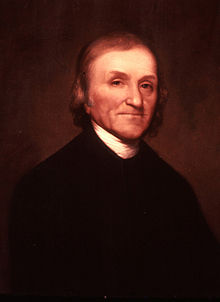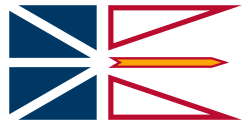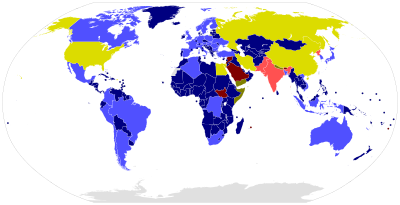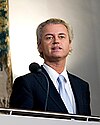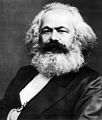Portal:Politics
| Main | Topics and categories | Tasks and projects |
The Politics portal
Politics (from Ancient Greek πολιτικά (politiká) 'affairs of the cities') is the set of activities that are associated with making decisions in groups, or other forms of power relations among individuals, such as the distribution of resources or status. The branch of social science that studies politics and government is referred to as political science.
It may be used positively in the context of a "political solution" which is compromising and non-violent, or descriptively as "the art or science of government", but also often carries a negative connotation. The concept has been defined in various ways, and different approaches have fundamentally differing views on whether it should be used extensively or in a limited way, empirically or normatively, and on whether conflict or co-operation is more essential to it.
A variety of methods are deployed in politics, which include promoting one's own political views among people, negotiation with other political subjects, making laws, and exercising internal and external force, including warfare against adversaries. Politics is exercised on a wide range of social levels, from clans and tribes of traditional societies, through modern local governments, companies and institutions up to sovereign states, to the international level.
In modern nation states, people often form political parties to represent their ideas. Members of a party often agree to take the same position on many issues and agree to support the same changes to law and the same leaders. An election is usually a competition between different parties.
A political system is a framework which defines acceptable political methods within a society. The history of political thought can be traced back to early antiquity, with seminal works such as Plato's Republic, Aristotle's Politics, Confucius's political manuscripts and Chanakya's Arthashastra. (Full article...)
Selected article
The unification of Germany into a politically and administratively integrated nation state officially occurred on 18 January 1871 at the Versailles Palace's Hall of Mirrors in France. Princes of the German states gathered there to proclaim Wilhelm of Prussia as Emperor Wilhelm of the German Empire after the French capitulation in the Franco-Prussian War. Unofficially, the transition of most of the German-speaking populations into a federated organization of states occurred over nearly a century of experimentation. Unification exposed several glaring religious, linguistic, and cultural differences between and among the inhabitants of the new nation, suggesting that 1871 really only represents one moment in a continuum of the larger unification processes. Historians debate whether or not Otto von Bismarck, the Minister President of Prussia, had a master-plan to expand the North German Confederation of 1866 to include the remaining independent German states into a single entity, or whether he simply sought to expand the power of the Kingdom of Prussia. They conclude that factors in addition to the strength of Bismarck's Realpolitik led a collection of early modern polities to reorganize political, economic, military and diplomatic relationships in the 19th century. By establishing a Germany without Austria, the political and administrative unification in 1871 at least temporarily solved the problem of German dualism.
Featured picture

Photo taken by a Lockheed U-2 spy plane of the San Cristobal MRBM launch site in Cuba, November 1962, after the Cuban Missile Crisis. Although this image was taken days after the crisis had ended (October 28), this image has become iconic of the crisis to the point where it is often cited incorrectly as having been taken during the crisis.
The prime minister of Luxembourg (Luxembourgish: Premierminister vu Lëtzebuerg; French: Premier ministre luxembourgeois; German: Premierminister von Luxemburg) is the head of government of Luxembourg. The prime minister leads the executive branch, chairs the Cabinet and appoints its ministers.
Since 1989, the title of Prime Minister has been an official one, although the head of the government had been unofficially known by that name for some time. Between 1857 and 1989, the prime minister was styled the President of the Government, with the exception of the 25-day premiership of Mathias Mongenast. Before 1857, the prime minister was the President of the Council. In addition to these titles, the prime minister uses the title Minister of State, although this is usually relegated to a secondary title. (Full article...)
The governor of Florida is the head of government of the U.S. state of Florida and the commander-in-chief of the state's military forces. The governor has a duty to enforce state laws and the power to either approve or veto bills passed by the Florida Legislature, to convene the legislature and grant pardons, except in cases of impeachment.
When Florida was first acquired by the United States, future president Andrew Jackson served as its military governor. Florida Territory was established in 1822 and five people served as governor over 6 distinct terms. The first territorial governor, William Pope Duval, served 12 years, the longest of any Florida governor to date. (Full article...)

The Bharatiya Janata Party (BJP) is one of the two major parties in the political system of the Republic of India, the other being the Indian National Congress (INC). , it is the country's largest political party in terms of representation in the national parliament. Established in 1980, the BJP's platform is generally considered as the right-wing of the political spectrum. , 52 BJP leaders have held the position of a chief minister and Deputy Chief Minister out of which twelve and Eleven are incumbent.
A chief minister is the head of government of each of the twenty-eight states and three union territories (UTs) (Delhi, Jammu and Kashmir and Puducherry). According to the Constitution of India, at the state-level, the governor is de jure head, but de facto executive authority rests with the chief minister. Following elections to the state legislative assembly, the governor usually invites the party (or coalition) with a majority of seats to form the government. The governor appoints the chief minister, whose council of ministers are collectively responsible to the assembly. The chief minister's term is usually for a maximum of five years, with the confidence of the assembly's confidence. There are no limits to the number of terms the chief minister can serve. Deputy Chief Minister is a member of the state government and usually the second highest ranking executive officer of their state's council of ministers. While not a constitutional office, it seldom carries any specific powers.[1] A deputy chief minister usually also holds a cabinet portfolio such as home minister or finance minister. In the parliamentary system of government, the Chief Minister is treated as the "first among equals" in the cabinet; the position of deputy chief minister is used to bring political stability and strength within a coalition government. (Full article...)
In 1831, Belgium was divided into 2,739 municipalities, including 20 within the current Brussels-Capital Region (which at that time did not exist). In 1841, a 21st and 22nd municipality were created when Berchem-Sainte-Agathe formally separated from neighbouring Koekelberg and Jette-Ganshoren split into Jette and Ganshoren. Since then, three municipalities have been merged with the City of Brussels: Laeken, Haren, and Neder-Over-Heembeek, in 1921. Unlike most of the municipalities in Belgium, the ones located in the Brussels-Capital Region were not merged with others during mergers occurring in 1964, 1970, and 1975. However, many territorial changes have occurred, predominantly between the City of Brussels and its neighbouring municipalities. (Full article...)

The Maryland Senate is the upper house of the Maryland General Assembly, the state legislature of the U.S. State of Maryland. One Senator is elected from each of the state's 47 electoral districts. As of January 2023, 34 of those seats are held by Democrats and 13 by Republicans. The leader of the Senate is known as the President, a position currently held by Bill Ferguson, who represents Baltimore. In addition, senators elect a President Pro Tempore, and the respective party caucuses elect a majority and minority leader and a majority and minority whip.
Senators are elected in even-numbered years when the President of the United States is not being elected, similar to most other state offices in Maryland. The most recent election was in November 2022. Senators are not term-limited. Should a Senator resign from office before his or her term expires, the local central committee of the party to which the retiring senator belonged makes a recommendation to the Governor for whom to appoint to the open seat. It is tradition for the Governor to appoint the recommended person. Nine of the current members of the Maryland State Senate were originally appointed, all of whom have since been elected in their own right. Newly elected senators are sworn in and begin work on the second Wednesday of the January following their election. (Full article...)
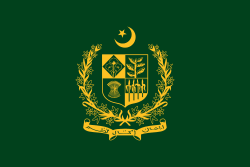
The prime minister of Pakistan (Urdu: وزير اعظم, romanized: Wazīr ē Aʿẓam, lit. 'Grand Vizier', Urdu pronunciation: [ʋəˈziːɾˌeː ˈɑː.zəm]) is the popularly elected politician who is the chief executive of the Government of Pakistan. The prime minister is vested with the responsibility of running the administration through his appointed federal cabinet, formulating national policies to ensure the safeguard of the interests of the nation and its people through the Council of Common Interests as well as making the decision to call nationwide general elections for the bicameral Parliament of Pakistan.
Since 1947, Pakistan has had eighteen prime ministers, aside from the appointed caretaker prime ministers who were only mandated to oversee the system until the election process was finished. In Pakistan's parliamentary system, the prime minister is sworn in by the president and usually is the chairman or the president of the party or coalition that has a majority in the National Assembly– the lower house of Pakistan Parliament. (Full article...)
Selected quote
Selected biography
Margaret Thatcher (1925–2013) was a British politician and the first female Prime Minister of the United Kingdom, a position she held from 1979 to 1990. She was a member of the Conservative Party and the figurehead of a political ideology known as Thatcherism. Even before coming to power she was nicknamed The Iron Lady in Soviet propaganda, an appellation which stuck. The changes she set in motion between coming to power and 1985 were profound, and altered much of the economic, cultural and commercial landscape of Britain and, by example, the world as a whole. Along the way she also aimed to roll back the welfare state, or "nanny state", as she termed it. Her popularity finally declined when she replaced the unpopular local government rates tax with the even less popular Community Charge. At the same time the Conservative Party began to split over her sceptical approach to Economic and Monetary Union of the European Union. Her leadership was challenged from within and she was forced to resign in 1990, her loss at least partly due to inadequate advice and campaigning.
Did you know (auto-generated) -

- ... that Satrio Sastrodiredjo and Moerachman, both former mayors of Surabaya, Indonesia, were held as political prisoners in the same prison after the 30 September Movement in 1965?
- ... that after a career as political journalist, Peter Merseburger wrote biographies of Der Spiegel founder Rudolf Augstein and chancellor Willy Brandt?
- ... that Disney once created a political advertisement for Dwight D. Eisenhower (featured)?
- ... that red-boxing by American politicians is used to coordinate with Super PACs, an activity that the Campaign Legal Center called the "primary mechanism for corruption of federal campaigns in 2022"?
- ... that Ingrid Andress came up with "Lady Like" after being rejected by a man when she brought politics up?
- ... that Rabab Al-Kadhimi was threatened with deportation from Egypt due to the political nature of her poetry?
More did you know...
- ...that a logocracy is government through words?
- ...that the Jewish Socialist Workers Party in the Russian Empire mobilized 3,000 of its cadres in self-defense militias during 1906?
- ...that the liberal film company Brave New Films has produced full-length videos and paper advertisements in addition to the viral videos for which it is known?
- ...that Nazi scientists claimed to have trained a dog to call "Adolf Hitler" as "Mein Führer"?
- ...that for many years, the Russian Soviet Republic did not have its Communist Party?
- ...that the World War II idea of Polish-Czechoslovakian confederation was eventually discarded by the Czechs, whose leader chose instead to believe in the Soviet Union promises of alliance?
- ...that Nunez Community College in Chalmette, Louisiana, is named for the late wife of former Louisiana State Senate President Samuel B. Nunez, Jr.?
- ...that in April 2009, Lim Hwee Hua became the first woman to be appointed a full Minister in Singapore's Cabinet?
In this month
- April 1, 1979 – Iran's government becomes an Islamic Republic by a 98% vote, overthrowing the Shah officially.
- April 9, 1948 – the period known as La Violencia begins with the assassination of Colombian Liberal Party leader Jorge Eliécer Gaitán. For the next ten years Liberals, Communists and Conservatives would fight each other in the conflict.
- April 9, 2003 – Government of Saddam Hussein overthrown by American forces in Iraq.
- April 19, 2006 – Han Myung-sook becomes South Korea's first female Prime Minister.
- April 24, 2005 – Presidential elections in Togo return Faure Gnassingbe to power two months after he was installed by the military following the death of his father, Gnassingbé Eyadéma.
- April 28, 1937 – Saddam Hussein, the President of Iraq was born.
- April 30, 1945 – Adolf Hitler and his wife Eva Braun, commit suicide as the Red Army approached the Führerbunker in Berlin. Karl Dönitz succeeds Hitler as President of Germany; Joseph Goebbels succeeds Hitler as Chancellor of Germany.
News and Current events
- August 11: 4 local government areas in New South Wales, Australia locked down after COVID-19 case
- August 11: Australia: AstraZeneca vaccine access expanded by Victorian government
- August 1: Australia: Victorian lockdown lifted
- July 29: Tunisia's president dismisses prime minister, suspends parliament
- July 25: Australia: Wikinews interviews Reg Kidd, mayor of the City of Orange, about COVID-19 lockdown and local government
- July 23: South Australia enters week-long lockdown to contain COVID-19 Delta variant spread
- July 21: Technological University Dublin senior lecturer Dr Lorcan Sirr speaks to Wikinews on housing market in Ireland
- July 21: Three rural councils in New South Wales, Australia enter 7-day lockdown
- July 21: Australia: Victoria lockdown extended by a week with 85 active cases recorded
- July 15: California governor signs new state budget, eligible Californians to get stimulus payments
Topics and categories
General images
Related portals
Associated Wikimedia
The following Wikimedia Foundation sister projects provide more on this subject:
-
Commons
Free media repository -
Wikibooks
Free textbooks and manuals -
Wikidata
Free knowledge base -
Wikinews
Free-content news -
Wikiquote
Collection of quotations -
Wikisource
Free-content library -
Wikiversity
Free learning tools -
Wiktionary
Dictionary and thesaurus


![Image 1 Priestley, painted late in life by Rembrandt Peale (c. 1800) Joseph Priestley (1733–1804) was a British natural philosopher, Dissenting clergyman, political theorist, theologian, and educator. He is best known for his discovery, simultaneously with Antoine Lavoisier, of oxygen gas. A member of marginalized religious groups throughout his life and a proponent of what was called "rational Dissent," Priestley advocated religious toleration and equal rights for Dissenters. He argued for extensive civil rights in works such as the important Essay on the First Principles of Government, believing that individuals could bring about progress and eventually the Millennium; he was the foremost British expounder of providentialism. Priestley also made significant contributions to education, publishing, among other things, The Rudiments of English Grammar, a seminal work on English grammar. In his most lasting contributions to education, he argued for the benefits of a liberal arts education and of the value of the study of modern history. In his metaphysical works, Priestley "attempt[ed] to combine theism, materialism, and determinism," a project that has been called "audacious and original." (Full article...)](https://upload.wikimedia.org/wikipedia/en/d/d2/Blank.png)
